
views
Building Up Your Endurance
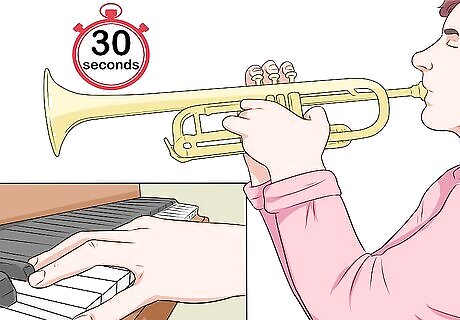
Work on holding a single note in tune. Choose a note in the lower register. Play it on your trumpet for 30 seconds at first. Keep practicing until you can work up to 2 minutes or more at a single time. If you are worried about playing the right note, use a keyboard or piano and try to match it.
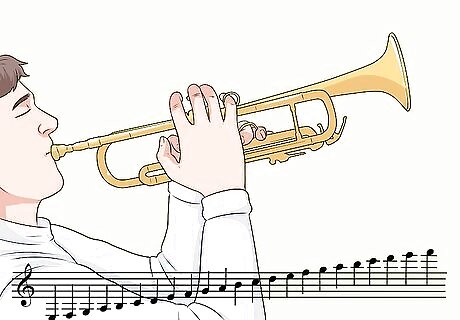
Move up and down a scale. Play 3 notes up, 5 notes up, and then go back down. Keep moving up and down the notes. Try to push a little bit higher each time. It’s okay if you can’t hold the high notes for as long. This is mainly about improving your ability to move between notes.
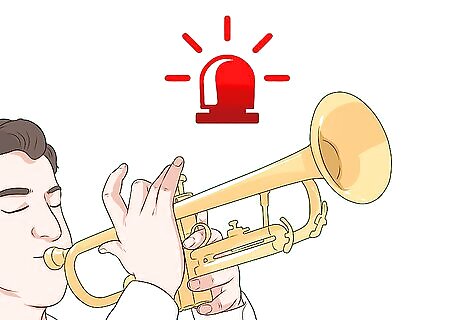
Play a “siren.” Try to go from the middle of your range to the bottom, to the top, and then to the middle. If you can do this without breaks, it is a great breathing work-out.
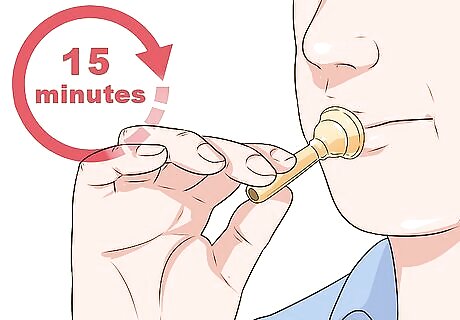
Exercise your lips. Get out your trumpet mouthpiece and buzz your lips against it. Do this every day for 15 minutes. Continue this for 4 to 8 weeks. After the 8 weeks is up, you can reduce this time to 1 to 2 minutes each day. Another lip exercise is to place a pencil in between your lips and hold it out in front of you. Do this daily and try to keep it in position for 3 to 4 minutes.
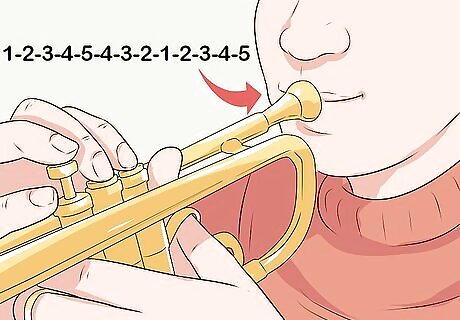
Do a five-note exercise. Hitting the C note is the entry-point into the higher range. Start by playing on the low F# then do a lip slur for 5 notes. Count them out, like 1-2-3-4-5-4-3-2-1-2-3-4-5. Then, repeat this process as you move up the scale. The goal here is to be consistent in hitting and moving between notes using only the power of your lips. A lip slur is an exercise, often used by brass players, that involves creating and changing notes by using your lips alone. These exercises are often played in descending order and by notes with the same fingering. For example; G-C-G, F sharp-B-F sharp, F-B flat-F, and so on...
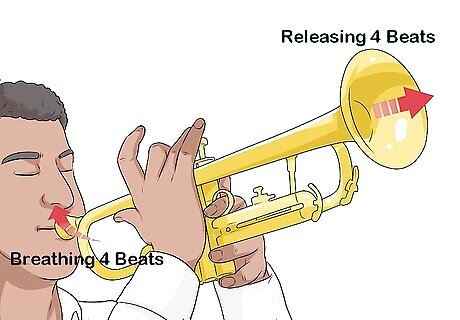
Do breathing exercises. Pull a deep breath into your lungs over the course of 4 beats. Release the air out of your mouth over the course of 4 beats. Then, inhale for 3 beats and exhale for 4. Then, inhale for 2 beats and exhale for 4. The goal here is to make the same amount of air last longer, which is what you’ll need to reach a high note. You can also do the bottom-middle-top exercise where you breath from your gut first, then your chest, then your throat, and breath out. You go can change the speed and how long you hold to adjust to your needs. For example, you could breath in for 12 out for 12 if you want to practice a piano dynamic. You could also do in for 4 out for 4 for mezzo-forte. You can also get a stopwatch and time how long it takes for you to release 2 beats worth of air. See if you can extend this time with practice.
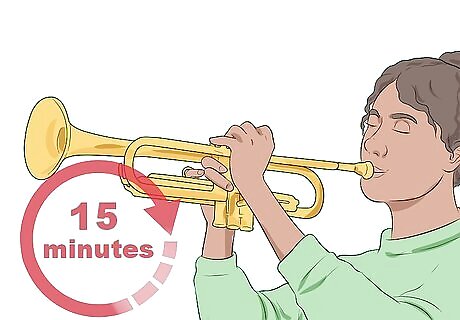
Practice every day for at least 15 minutes. If you try to practice each day for hours you’ll wear out your tongue, lips, and throat. However, it’s a good idea to spend at least 15 minutes each day either exercising your lips or actually playing. This will gradually build up your endurance for playing the trumpet.
Heading into a High Note
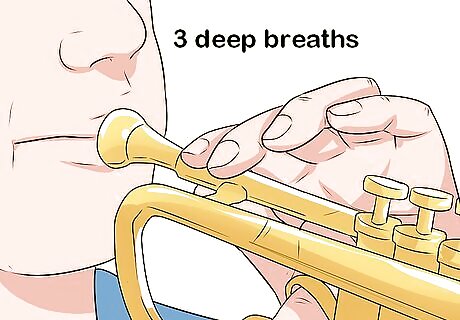
Start by generating a low buzz. Take 3 deep breaths and exhale them. Pick up your trumpet and place the mouthpiece against your mouth. Blow air into the mouthpiece until you are emitting a low, consistent buzzing sound. Hold this buzz for 2 to 3 minutes.
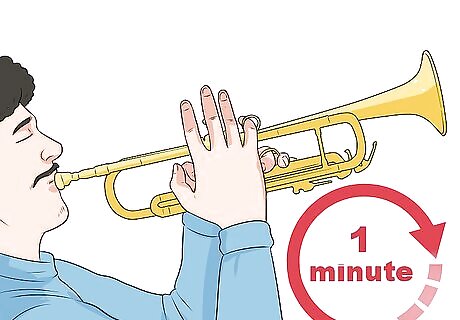
Blow through the horn for about 1 minute without playing any notes. Keep your airflow constant by taking deep breaths into your lungs and exhaling directly into your trumpet. Start playing immediately after inhaling in order to get the most benefit.

Work your way up the scales. Drawing out your tones and notes, start playing the C scale. Gradually move through the scales after C, heading into the high notes. Take your time doing this. The entire exercise should take between 10 to 15 minutes.
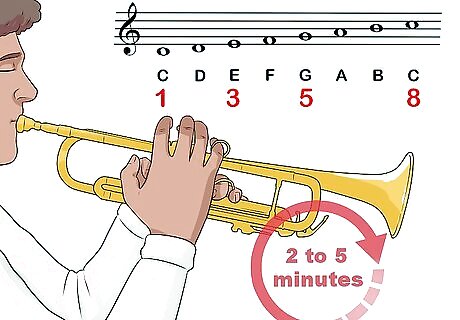
Play some arpeggios. Start at C and move through the keys 1-3-5-8. Again, work your way up the scales. This part of your warm-up should take between 2 to 5 minutes.
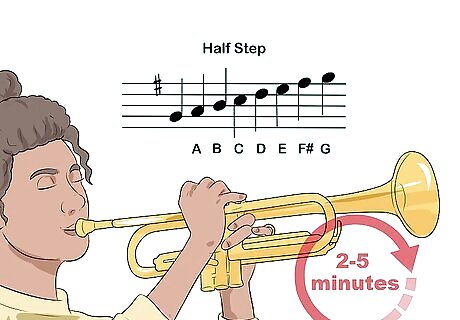
Jump into high note playing. Start with G (concert F). Try your best to keep this note steady for around 4 beats. Then, every 2 beats, move another half-step up the scale. Stop and take a break when you reach high C (concert Bb). This entire exercise should take between 2 to 5 minutes. If you continue to struggle, go back to the strengthening exercises for a few days before trying again.
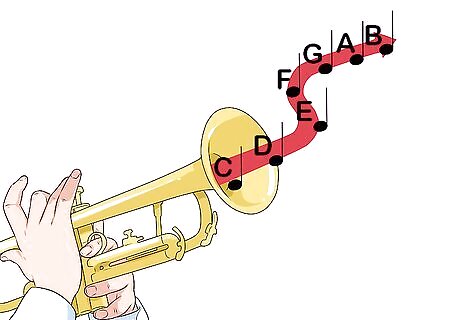
Work on expanding your range through lip slurs. Start on C (concert Bb) and slur up and down from there while keeping the same fingering. Keep your slur slow so you can center each note as it's played. Gradually work up the scale, by half-step, as high as you're able to play.
Improving Your Technique

View every step on the scale as interrelated. Some people develop almost a mental block that stops them from heading into high notes. It helps to break down the scales in your mind and to envision how every step is not very far removed from those above or below it. Also, one person’s high note could be someone else’s baseline.

Control your airflow instead of blowing harder. Many trumpet players try to achieve high notes by putting more pressure on the mouthpiece. This may make the volume increase, but it will do very little to heighten the sound. Instead, focus on controlling the airflow from your lungs through your lips. You can actually reach notes “above” C with very little air.
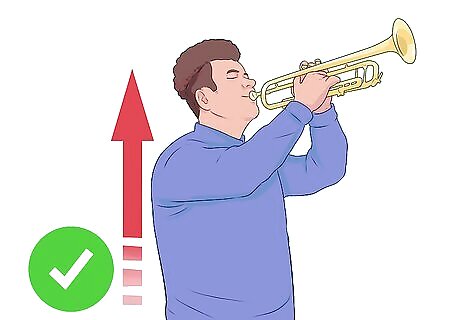
Maintain an upright posture. You can either stand or sit to play the trumpet. Regardless of your position, make sure to keep your spine straight. This lets the air go in a direct line from your lungs to your mouth and into the mouthpiece. You may see some players slouching, however, it’s best not to try this when you are working on high notes. Try playing while looking into a full-length mirror. This will let you check your posture while you play. Always keep your shoulders back and your trumpet between parallel and 1 degrees above.
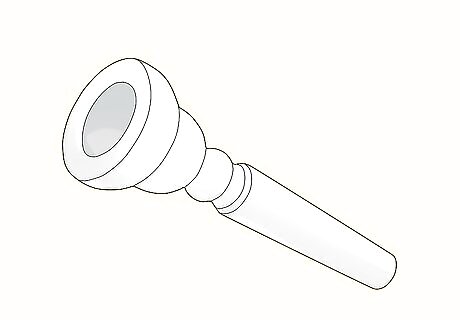
Use a smaller mouthpiece. You should be able to play a high note on any type of mouthpiece. However, some players find that a smaller mouthpiece makes it easier to climb higher on the scale. If you find that your lip positioning is a bit loose, then a smaller mouthpiece might force you to tighten up. This, in turn, may create a higher pitch.

Arch your tongue while playing. Experiment with raising up your tongue as you try to move up the scales. Imagine that you are making the noise or vowel sound “ee.” This creates a funnel for air to pass through your mouth and into the mouthpiece. As a result, the air will move faster and help you reach a higher pitch. The opposite of this approach is lowering the tongue and making an “ah” sound.
















Comments
0 comment